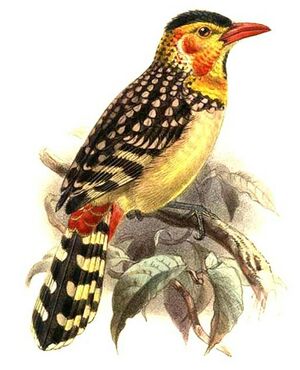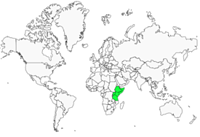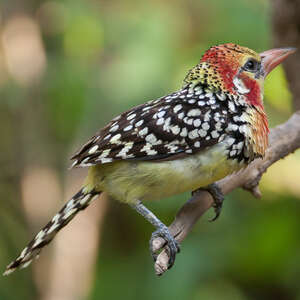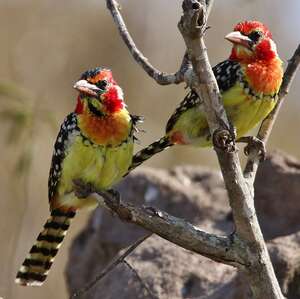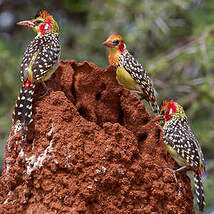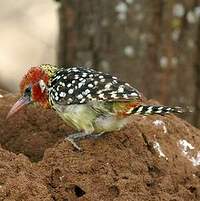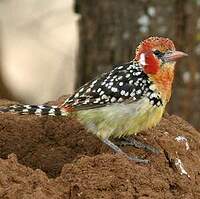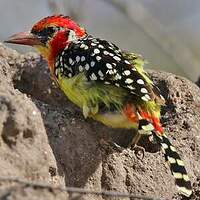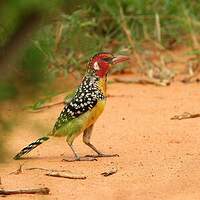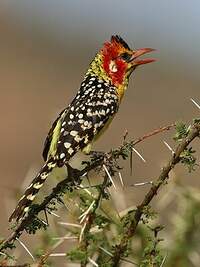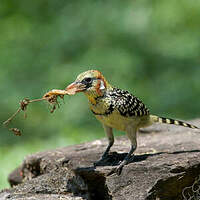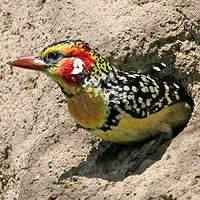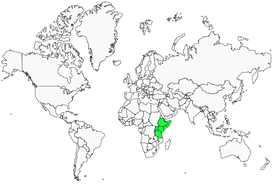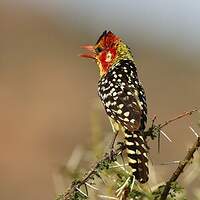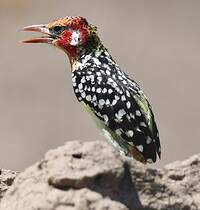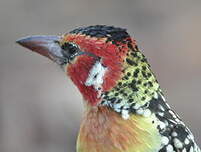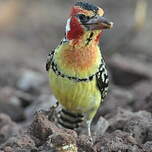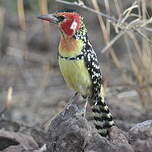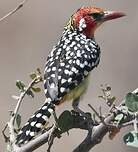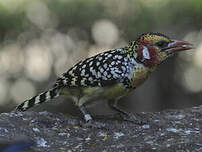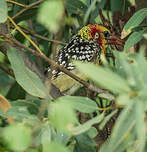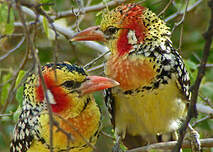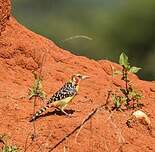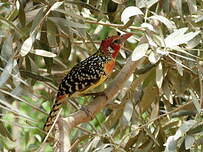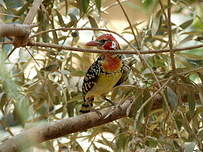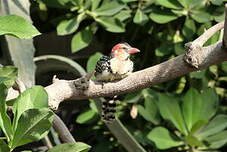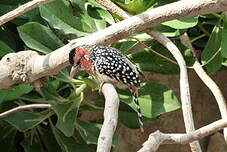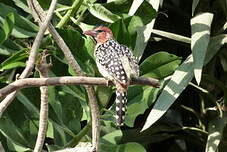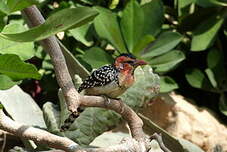Red-and-yellow Barbet
Trachyphonus erythrocephalus - Barbican à tête rouge
Identification
The Red-and-yellow Barbet, a bit bigger than its counterpart and fellow gardener the Arnaud Barbet, has a brightly coloured plumage, red, yellow, black and white. Its head combines these four colours with red dominant and a white comma marking on the ear being a good criterion to identify it in case of doubt. The crown feathers, which can be raised in a small crest, are red, more or less blended with black. The nape is yellow dotted with black. The chest is yellow-orange or orange, the belly being divided by a black punctured with white line. A bit of red at the base of the tail can be noticed above and below. The mantle and the wings are black, punctuated with white and light yellow, and the long black rectrices are incompletely bar marked with light yellow.
The male of the nominate race has a black cap, this one being more reduced in the other subspecies. The female has an orange-red head with few black patches. She can have a small black moustache.
The immatures of the Red-and-yellow Barbet are similar to the adults, but more dull.
Subspecific information 3 subspecies
- Trachyphonus erythrocephalus erythrocephalus (c Kenya to n Tanzania)
- Trachyphonus erythrocephalus shelleyi (e Ethiopia and Somalia)
- Trachyphonus erythrocephalus versicolor (se Sudan, s Ethiopia, n Kenya and ne Uganda)
Foreign names
- Barbican à tête rouge,
- Barbudo cabecirrojo,
- barbaças-de-cabeça-vermelha,
- Flammenkopf-Bartvogel,
- Vuurkopbaardvogel,
- Barbetto giallorosso,
- termitbarbett,
- Termittperleskjeggfugl,
- perlavec červenohlavý,
- vousák červenožlutý,
- Pragtperleskægfugl,
- helmiseppä,
- barbut de cap vermell,
- brodal czerwonouchy,
- Огненноголовый трахифонус,
- ホオアカオナガゴシキドリ,
- 红黄拟啄木鸟,
- 紅黃擬啄木,
Voice song and cries
Habitat
Behaviour character trait
Red-and-yellow Barbets live in groups that can sometimes be up to ten individuals, which are often two couples and four or five subadults of both sexes who act as helpers.
The group can also be structured around a single couple. Generally, the group is quite loose but it can quickly come together in times of danger.Red-and-yellow Barbets are very territorial and show their territoriality to both their own species and other species. They often come close to humans and take part in their activities, sometimes even entering their houses to get food.
At night they return to the holes they have dug, often in termite mounds. The hole can be shared by the dominant couple and the helpers. In the morning, members of the group exchange greeting calls, rotating their heads and listening to the replies from neighbouring groups.
Dietfeeding habits
The Red-and-yellow Barbet has a very varied diet. While they enjoy termites, they can also consume other invertebrates, lizards, eggs, and even nestlings, as well as fruits and seeds.
They can also forage in man-made waste and reserves, not shying away from bread or even meat. Their taste for insects can also bring them to explore car windscreens and hoods where their corpses accumulate.In fact, it is an opportunistic bird capable of finding food in any accessible place, whether in nature or in villages.
Reproduction nesting
Reproduction occurs year-round, although it is dependent on the rainy season and most often occurs during or at the end of the season.
After a display from the male, with its tail raised and crest raised, the mates preen each other, followed by copulation. Nesting is done in a cave. The nest is located at the bottom of a tunnel about 40 cm in length, 1-4 m in height depending on the substrate (termite mound, steep bank, etc.). It is not known if helpers take part in the work. Laying is of two to six eggs. The male is mainly responsible for the incubation, at least in captivity, and he also mainly provides food for the young, helped then by the helpers. The Red-and-yellow Barbet can raise several broods a year if the conditions are favorable.Geographic range
The Red-and-yellow Barbet is found in east Africa, from Somalia and Ethiopia in the north, to Tanzania in the south. Further west, its range covers the north-east of Uganda and the extreme south of Sudan. It is a sedentary bird, but can move within its range, depending on climatic conditions and food opportunities.
Threats - protection
IUCN conservation status
concern
in the Wild
threatened
evaluated
The Red-and-yellow Barbet is quite widespread in its distribution area. It is dominant over other species of barbet and woodpeckers. At the moment, the species is not considered globally threatened.
Searching for colourful feathers by some tribes, as well as raiding of nests by children, along with capture for amusement, are the main known threats.
Sources of information
- IOC World Bird List (v14.1), Gill, F and D Donsker (Eds). 2024-04-18.
- Birds of East Africa: Kenya, Tanzania, Uganda, Rwanda, Burundi, Terry Stevenson, John Fanshawe
- Birds of Kenya and Northern Tanzania, Dale A Zimmerman, Donald A Turner, David J Pearson
- HBW Alive,
- IUCN Red List of Threatened species,
Other sources of interest
 Specification sheet created on
30/07/2023 by Catherine et Bernard Lanneluc
Specification sheet created on
30/07/2023 by Catherine et Bernard LannelucTranslation by AI Oiseaux.net
published: 18-02-2016 - Updated: 30-07-2022
© 1996-2024 Oiseaux.net
- Accipitriformes
- Aegotheliformes
- Anseriformes
- Apodiformes
- Apterygiformes
- Bucerotiformes
- Caprimulgiformes
- Cariamiformes
- Casuariiformes
- Charadriiformes
- Ciconiiformes
- Coliiformes
- Columbiformes
- Coraciiformes
- Cuculiformes
- Eurypygiformes
- Falconiformes
- Galliformes
- Gaviiformes
- Gruiformes
- Leptosomiformes
- Mesitornithiformes
- Musophagiformes
- Nyctibiiformes
- Opisthocomiformes
- Otidiformes
- Passeriformes
- Pelecaniformes
- Phaethontiformes
- Phoenicopteriformes
- Piciformes
- Podargiformes
- Podicipediformes
- Procellariiformes
- Psittaciformes
- Pterocliformes
- Rheiformes
- Sphenisciformes
- Steatornithiformes
- Strigiformes
- Struthioniformes
- Suliformes
- Tinamiformes
- Trogoniformes

